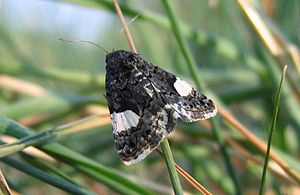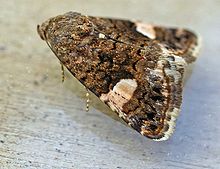Bindweed mourning owl
| Bindweed mourning owl | ||||||||||||
|---|---|---|---|---|---|---|---|---|---|---|---|---|

Bindweed mourning owl ( Tyta luctuosa ) |
||||||||||||
| Systematics | ||||||||||||
|
||||||||||||
| Scientific name of the genus | ||||||||||||
| Tyta | ||||||||||||
| Billberg , 1820 | ||||||||||||
| Scientific name of the species | ||||||||||||
| Tyta luctuosa | ||||||||||||
| ( Denis & Schiffermüller , 1775) |
The bindweed-mourning owl , or field -coral wind- owl ( Tyta luctuosa ) is a butterfly ( moth ) from the family of owl butterflies (Noctuidae). The species is the only species of the genus Tyta , which in turn is the only genus of the tribe Tytini . The moths are diurnal and nocturnal.
features
The moths reach a wingspan of 22 to 26 millimeters. The front wings are black-brown to black. On its front edge there is a white, yellowish-white to slightly pink-colored, rounded, square spot in front of the wing tip. The hind wings are also black-brown to blackish with a broad, wavy, white central band. There is still a small white spot on the edge of the wing. The fringes of the fore and hind wings are mostly white. The drawing and coloration can vary somewhat: specimens with a narrow white central band on the hind wing were formerly also called forma angustifascia , specimens with a reddish spot on the forewing as forma ochracea . Today these "formae" are mostly no longer used or only used informally.
The caterpillars are relatively strong and thinning towards the front. They are yellow-gray to brown at the top and lighter in color at the bottom. The back line and the side back line are slightly darker than the basic color. The head is relatively small, light gray and speckled with darker spots. Adult caterpillars are 28 to 33 mm long. The back line is weakly developed, the side back line a little more distinct and yellowish. The doll is red-brown.
Geographical distribution and habitat
The bindweed mourning owl is common in western, southern and eastern Europe. In north-west Germany, Belgium, the Netherlands and Denmark (with the exception of Bornholm) the species is absent. It still occurs in small populations in England. It has also been proven in southern Fennoscandia . Occurrences outside Europe exist in North Africa (Tunisia, Algeria and Morocco), Asia Minor, Cyprus, the Caucasus, Kazakhstan and from Siberia to China. In Asia, the southern border of the area runs through Afghanistan, Pakistan and northern India. It can be found relatively often on dry, grassy meadows, steppe heaths, wasteland, clover fields and fallow land and occurs in the lowlands up to an altitude of 1600 m in the Alps. The species is an internal migratory species that in some years migrates north and northwest to areas where it is not normally found.
In North America, Tyta luctuosa was released in the 1980s to control bindweed ( Convolvulus arvensis ). Survival has been observed over the winter; however, it does not seem to have established itself.
Way of life
The species flies in Central Europe in two overlapping generations from late April to June and then again from July to September. The second generation is often incomplete. In southern Europe, two generations and often an incomplete third generation are regularly formed. The moths fly here from May to June, from July to August and from September to October. The moths are diurnal and nocturnal and come to light at night. The females lay an average of around 400 eggs on the stems and flower buds of the host plants. The caterpillars appear from May. They feed mainly on bindweed ( Convolvulus arvensis ). Other food plants mentioned in the literature are flax ( Linum ), bindweed ( Calystegia ), plantain ( Plantago ) and goose feet ( Chenopodium ). The caterpillars are nocturnal, during the day they hide between the leaves of the food plants. Five larval stages are formed. Pupation takes place in a solid cocoon in the ground, the pupa overwinters.
Under ideal laboratory conditions, the development from egg to butterfly takes just under 46 days.
Danger
The species has become rare in some German federal states and is classified as endangered in Bavaria and Saxony. In Mecklenburg-Western Pomerania and North Rhine-Westphalia it is viewed as critically endangered. However, it has always been rare here. In Brandenburg it is on the advance warning level.
Nomenclature and systematic position
In older works the species is listed under the genus Tarache . This name is now considered a synonym for Acontia and has nothing to do with the species described here. Forster and Wohlfahrt carry it under the name Acontia luctuosa . Accordingly, it was previously mostly placed in the subfamily Acontiinae. In some works, the genus is also a type of its own subfamily Tytinae or tribe Tytini. The standard work "Noctuidae Europaeae" presents the Tytini as a tribe to the subfamily Catocalinae . Fibiger and Hacker (2005) and Fibiger and Lafontaine (2005) did not take this step. They put the genus Tyta in the subfamily Metoponiinae.
swell
literature
- Arno Bergmann: The large butterflies of Central Germany. Volume 4/2: Owls. Distribution, forms and communities. Urania-Verlag, Jena 1954, DNB 450378381 .
- Walter Forster , Theodor A. Wohlfahrt : The butterflies of Central Europe. Volume 4: Owls. (Noctuidae). Franckh'sche Verlagshandlung, Stuttgart 1971, ISBN 3-440-03752-5 .
- Günter Ebert (Ed.): The Butterflies of Baden-Württemberg Volume 5, Moths III (Sesiidae, Arctiidae, Noctuidae). Ulmer Verlag Stuttgart 1997. ISBN 3-8001-3481-0
- Barry Goater, László Ronkay & Michael Fibiger: Noctuidae Europaeae 10. Catocalinae & Plusiinae. Entomological Press, Sorø 2003 ISBN 87-89430-08-5
- Manfred Koch : We determine butterflies. Volume 3: Owls of Germany. Neumann, Radebeul / Berlin 1958, DNB 452481937 .
- Michael Fibiger and J. Donald Lafontaine: A review of the higher classification of the Noctuoidea (Lepidoptera) with special reference to the Holarctic fauna. Esperiana, 11: 7-92, Schwanfeld 2005 ISBN 3-938249-01-3
- Michael Fibiger and Hermann H. Hacker: Systematic list of the Noctuoidea of Europe (Notodontidae, Nolidae, Arctiidae, Lymantriidae, Erebidae, Micronoctuidae, and Noctuidae). Esperiana, 11: 93-205, Schwanfeld 2005 ISBN 3-938249-01-3
Individual evidence
- ↑ a b c d S. S. Rosenthal, SL Clement, N. Hostettler & T. Mimmocchi: Biology of Tyta luctuosa (Lep .: Noctuidae) and its potential value as a biological control agent for the weed Convolvulus aroensis. Entomophaga 33: 185-192, 1988 doi : 10.1007 / BF02372653
- ^ Peter G. Mason, John Theodore Huber: Biological control programs in Canada, 1981-2000. 410 pp., Farnham Royal, Commonwealth Agricultural Bureaux, 1984 Online at Google books
- ^ Red List , accessed May 24, 2009.
Web links
- Butterflies-Deutschlands.de
- Lepiforum: Taxonomy and Photos
- Moths and Butterflies of Europe and North Africa (English)
- Markku Savela: Lepidoptera and some other life forms (English)
- Tyta luctuosa at Fauna Europaea
- UK Moths (English)
- Bernd Schacht: Noctuidae.de
